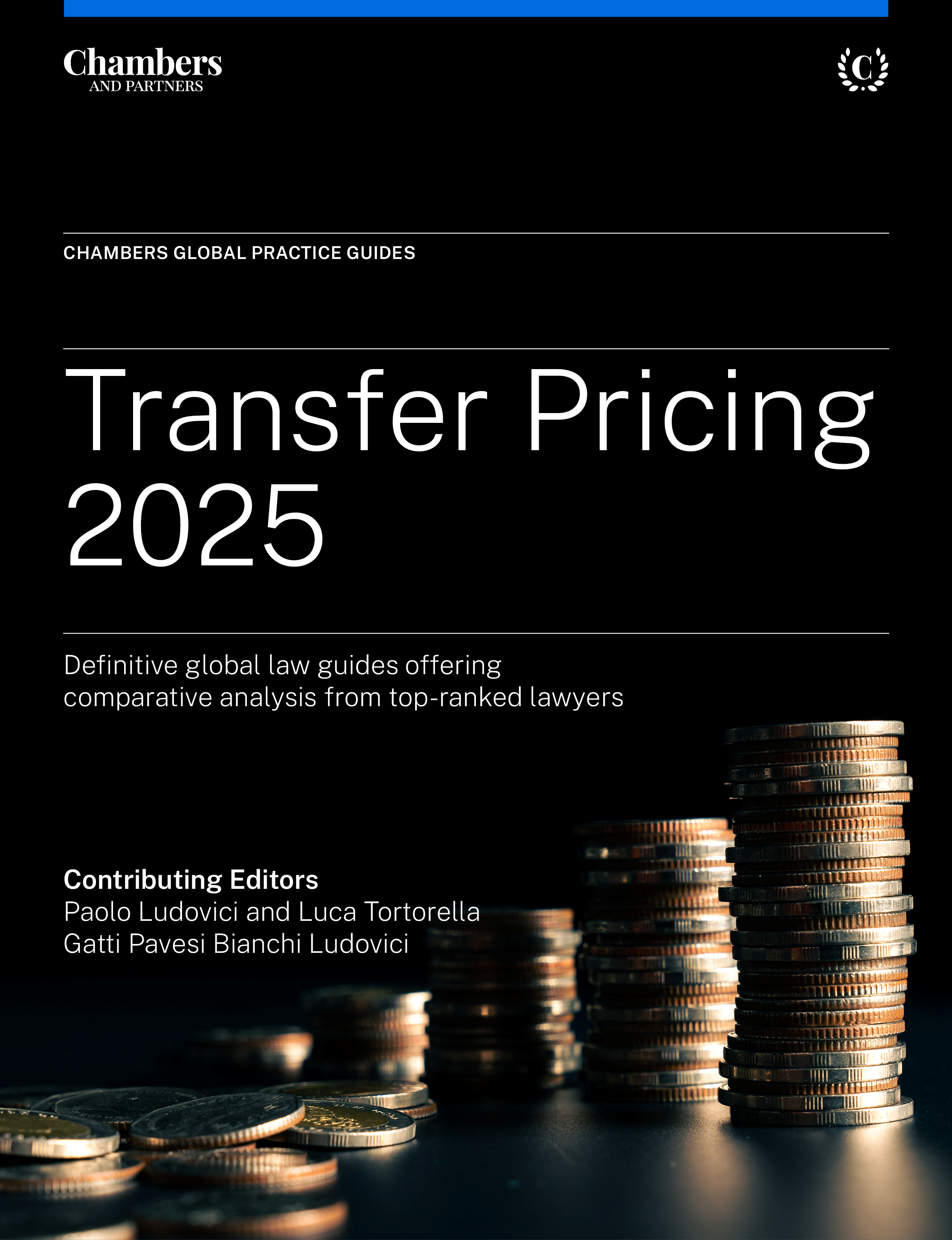
Transfer Pricing 2025
The new Transfer Pricing 2025 guide covers 15 jurisdictions. The guide provides the latest legal information on the rules governing transfer pricing and their alignment with OECD guidelines, the definition of control/related parties, transfer pricing methods and their selection, the pricing of intangible and pricing adjustments, information sharing and documentation, APAs, safe harbours, and transfer pricing controversies.
Last Updated: April 10, 2025
Compare law and practice by selecting locations and topic(s)
Select Locations

Select Topic(s)

Please select at least one location and one topic to use the compare functionality.
Global Overview of Transfer Pricing in 2025
International organisations and institutions have continued their efforts to standardise, harmonise and simplify transfer pricing principles and compliance. These developments have been seen in individual jurisdictions around the world. In general terms, however, the recent trade policy of the new US administration – with the introduction of new tariffs on a case-by-case basis – is expected to have significant effects on global value chains and transfer pricing policies. This is in addition to the decision to withdraw from the Two-Pillar solution addressing tax challenges (see below for more details). As a result, the coming year is expected to bring substantial changes in transfer pricing, requiring businesses to stay vigilant and adapt accordingly.
OECD Level
The implementation of the Two-Pillar solution, the OECD/G20 project to address tax issues related to the globalisation of the digital economy, has implications for how multinational groups apply transfer pricing rules.
Although some aspects of both Pillars may reduce the importance of the arm’s length principle (Pillar One, Amount A), other components (Pillar One, Amount B) increase the importance of the arm’s length standard.
The OECD global agreement on the taxation of multinational enterprises (MNEs) was signed in October 2021 after years of negotiations by all members of the Inclusive Framework (currently 145 jurisdictions), and Pillar Two has already been implemented in several countries worldwide (where South Korea was the first country to sign the global minimum tax rules into law) and within the EU. It provided for a minimum 15% tax rate for large international corporations (Pillar Two) and a profit reallocation mechanism for the most profitable companies, especially digital giants (Pillar One), to ensure that the allocation of taxing rights by countries where customers are located to part of the business profits of large MNEs no longer requires physical presence in a jurisdiction. However, this fundamental international tax reform has been undermined by the recent decision to reject the “global tax deal” (the OECD global agreement on the taxation of MNEs) by the United States. With the White House memorandum of 20 January 2025, President Trump announced the withdrawal of the United States from the global tax deal.
Although the USA helped shape Pillar Two, it never ratified it. The new document signed by President Trump goes a step further: it declares null and void the commitments made by the previous United States administration and orders the Secretary of the Treasury to “investigate whether any foreign countries are not in compliance with any tax treaty with the United States or have any tax rules in place, or are likely to put tax rules in place, that are extraterritorial or disproportionately affect American companies”.
The US executive orders may also affect the adoption of the simplified and streamlined approach under Pillar One Amount B. Amount B simplifies the application of transfer pricing for baseline marketing and distribution activities. The final report recommends a streamlined approach for applying the most appropriate transfer pricing method to identify a fixed return to remunerate in-scope transactions involving baseline marketing distributors, such as wholesalers, sales agents and commissionaires for certain marketing and distribution activities. The report was incorporated into the OECD’s Transfer Pricing Guidelines for Multinational Enterprises and Tax Administrations (the “Transfer Pricing Guidelines”), and jurisdictions are deciding whether to introduce the simplified approach in their tax systems starting from fiscal years commencing on or after 1 January 2025.
Amount B can be implemented by jurisdictions according to two options: they can allow taxpayers to voluntarily adopt the simplified and streamlined approach (a safe harbour), or they can mandate its use for in-scope transactions.
Currently, only a few countries (eg, the Netherlands) have implemented Amount B into their domestic legislation, while the United States published a proposal for public consultation to incorporate the simplified and streamlined approach as an optional safe harbour, with the future possibility of making it mandatory for in-scope taxpayers.
As a consequence, any outcome deriving from the application of the simplified and streamlined approach is not (always) certain and cannot (always) be considered reliable for the purposes of a mutual agreement procedure (MAP), as amount B works on a level playing field only when all jurisdictions have applied the approach. The choice made by the Inclusive Framework in favour of a unilateral and elective approach seems to limit the effectiveness of the elimination of double taxation. Given the current status, Amount B seems to be only partially effective, and the only tool at the taxpayer’s disposal to achieve tax certainty remains the bilateral and multilateral advanced pricing arrangements (APAs), which – albeit only for ongoing procedures and new applications – prevent double taxation even with application of the simplified approach.
United Nations Level
The Subcommittee on Transfer Pricing established by the United Nations Committee of Experts on International Cooperation in Tax Matters has been completing its mandate of developing guidance in six workstreams:
- transfer pricing during the COVID-19 economic downturn;
- transfer pricing compliance assurance;
- transfer pricing of carbon offsets and credits;
- industry/sector guidance for agricultural products;
- industry/sector guidance for the pharmaceutical industry; and
- dispute avoidance and resolution. The noteworthy guidance released addresses practical challenges that developing countries are facing in the area of transfer pricing.
Subcommittee participants have already identified some elements for future workstreams on transfer pricing (intangibles and intragroup services) to be proposed to the next membership of the Committee.
EU Level
The most relevant initiatives at the EU level relate to the proposal for a Council Directive on transfer pricing and the implementation of the so-called public Country-by-Country Reporting (CbCR) Directive.
Proposal for a Council Directive on transfer pricing
In September 2023, the European Commission published a proposal to harmonise key transfer pricing rules of member states and ensure a common approach to the arm’s length’s principle within the EU. The proposed directive suggests alignment with the latest OECD guidelines and acknowledges the possibility that future guidelines may be issued by the UN.
The implementation date of the proposal is 1 January 2026. The European Parliament adopted its non-binding report in April 2024. Within the European Council, where unanimity is required for the adoption of the proposal, technical examination thereof is on-going, but several member states have concerns about the possibility of losing the flexibility they currently have in applying the OECD’s Transfer Pricing Guidelines, and this legislative proposal is not gathering sufficient support from member states. The majority of member states see no possibility of further progress on the basis of the current form of the Commission’s proposal. Nevertheless, a few member states hold the view that technical discussions should continue in order to determine if there are any relevant procedural aspects related to the transfer pricing rules (see the December 2024 report of the Economic and Financial Affairs Council (ECOFIN) to the European Council on tax issues).
Public CbCR Directive
The EU has long been at the forefront of advancing corporate tax transparency. Member states have transposed into their domestic legislation the Amending Directive to the Accounting Directive (2013/34) concerning the disclosure of income tax information by certain undertakings and branches (Directive 2021/2101), also known as the Public CbCR Directive.
At the end of 2024, the European Commission published the implementing regulation providing the common template and electronic reporting formats for applying the public CbCR Directive.
The Directive requires MNE groups to publish a report on income tax information, aiming to enhance transparency and allow public scrutiny of income tax data. This transparency enables debate on the contribution of MNEs in each EU member state through the taxes they pay. The framework of Directive 2013/34 is mandatory for MNEs operating in the EU, provided they exceed a size threshold. The Public CbCR Directive expanded this scope to include branches established in a member state by companies based outside the EU. MNE groups with consolidated revenue exceeding EUR750 million, and standalone undertakings with a taxable presence in at least two member states, must disclose CbCR data for operations within the EU, including in “non-cooperative jurisdictions”. The rules apply from the commencement of the first financial year starting on or after 22 June 2024.
The report must include corporate and financial information, such as company activities, a list of subsidiaries consolidated in the financial statements, number of employees, revenue, profits or losses and key income tax data, including taxes accrued and paid. This information will be published in national company registers for accessibility. Companies must also publish this information on their websites.
It is worth mentioning that outside Europe, a public CbCR regime has been implemented by Australia, applying to reporting periods starting 1 July 2024.
Tax Certainty and the Transfer Pricing Framework: Global Statistics for MAPs and APAs
On 15 November 2024, the OECD released its annual statistics on MAPs, including for the first time data on bilateral and multilateral APAs for 2023. These statistics monitor the implementation of Action 14 of the G20/OECD BEPS Project, which aims to verify the effectiveness of international tax dispute resolution mechanisms. The data covers 120 jurisdictions, providing a nearly complete representation of MAP cases worldwide. The APA statistics, derived from 46 jurisdictions, represent additional efforts under Action 14.
The global average MAP case closure time is 27.3 months (32 months for transfer pricing cases and 23 months for other cases). Trends show a slight decrease in open cases and a significant increase in closed cases. The success rate for agreements concluded is 74%. In the absence of an arbitration clause, competent authorities are required to make efforts to eliminate double taxation, though there is no specific obligation concerning the results.
As of 2020, there has been:
- a decrease in the number of ongoing disputes due to internal improvements in tax administration efficiency;
- a decrease in cases filed by taxpayers, likely due to a slowdown in tax audits during the pandemic; and
- an increase in procedures filed for non-transfer pricing cases, although transfer pricing cases remain predominant.
While fewer jurisdictions report bilateral and multilateral APAs, the data’s representativeness is still strong. The success rate for agreements is 25%, with an average closure time of 36.8 months. Bilateral APAs show increased efficiency and usage but remain time-intensive, making them more suitable for complex, high-value cases. The rise of co-operative compliance programmes and the OECD’s enhanced International Compliance Assurance Programme (ICAP) highlight the importance of adhering to the Transfer Pricing Guidelines.
However, participation in co-operative compliance programmes does not eliminate the risk of tax disputes in other jurisdictions involved in the same intercompany transactions. Transfer pricing, involving multiple jurisdictions, requires a strategic evaluation of tools to manage the risks of double taxation, as no single mechanism guarantees complete tax certainty.
Compliance With Transfer Pricing Rules: Relevance for Single States and Taxpayers
Beyond the strategic tools of co-operative compliance mentioned above, adherence to transfer pricing rules remains a key priority for both states and taxpayers.
For example, the Internal Revenue Service (IRS) in the United States has strengthened transfer pricing enforcement, driven by organisational changes and recent success in high-profile cases. Increased enforcement efforts aim to sustain this trend, including greater use of 20% and 40% penalties. The year 2024 was pivotal for transfer pricing following the US Supreme Court’s Loper Bright decision, which overturned the Chevron doctrine. Before this ruling, courts typically deferred to federal agencies’ interpretations of unclear statutes, granting considerable weight to Treasury Regulations under Section 482 of the US Internal Revenue Code. The Loper Bright decision now requires courts to independently interpret statutes without automatically deferring to agency regulations. This shift is already influencing tax cases, with courts scrutinising IRS rules more closely.
The French government has recently reinforced its approach to transfer pricing dispute resolution and prevention. The 2024 Finance Bill strengthened the powers of the tax authorities and led to a significant increase in dedicated resources. Moreover, in early 2025 draft guidelines on MAPs and APAs were released for public consultation.
The Swiss Federal Tax Administration published a Q&A list to clarify its domestic transfer pricing rules, aiming to offer maximum guidance to taxpayers. At the same time, non-compliance with transfer pricing rules might have criminal implications for employees and tax advisors according to recent case law.
Among compliance requirements, transfer pricing documentation plays a crucial role in mitigating potential penalties during tax audits. In this regard, Belgium in 2024, and Austria in 2025, implemented or revised transfer pricing documentation rules for in-scope corporate taxpayers, introducing significant changes for multinationals. Denmark has proposed updates to its transfer pricing documentation rules by raising financial thresholds for documentation requirements. Companies with controlled transactions below DKK5 million and intercompany balances under DKK50 million may be exempt, along with certain equity-related transactions. However, documentation remains mandatory for dealings involving intangible assets or noncooperative jurisdictions outside the EU/European Economic Area (EEA). Similarly, Cyprus updated its laws to align with OECD transfer pricing standards. Australia also continues to integrate OECD guidelines into its domestic legislation. Finally, although Italy has recently revised the penalties regime (also applicable to transfer pricing challenges), reducing the percentage of administrative penalties from 90% to 70% of additional taxes due in case of an audit, transfer pricing documentation in Italy remains essential to mitigate both potential cash outflows and criminal ramification when multinationals are subject to tax assessments. Therefore, the adequacy of documentation remains a focal point of disputes.
Finally, it is worth mentioning that the local transfer pricing framework in Brazil recently underwent significant reform, aligning with OECD guidelines and introducing the arm’s length principle into the local rules, which apply to a broad scope of controlled transactions, including cost-sharing agreements (CSAs), which were previously not explicitly covered. CSAs now face scrutiny under transfer pricing rules, but controversy remains regarding their classification as services and potential impacts on other taxes. The practical application of these new rules and their interpretation by tax authorities is yet to be fully tested.



